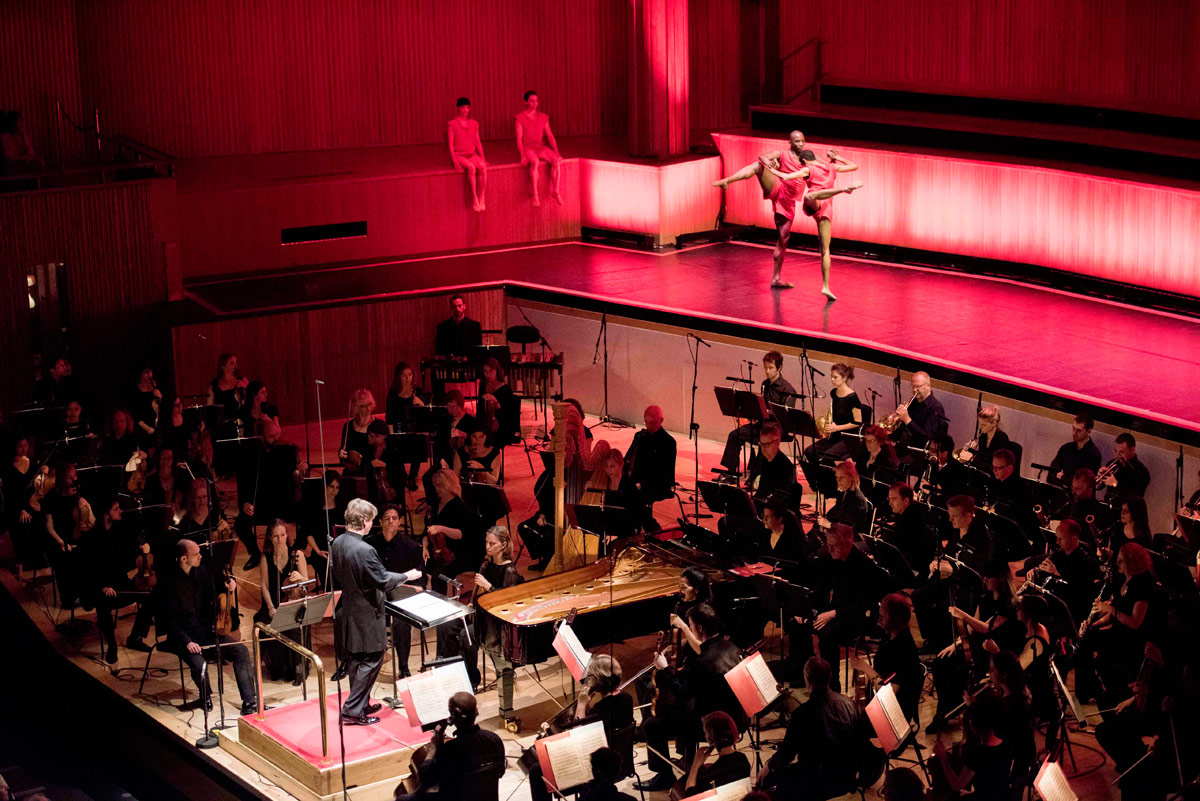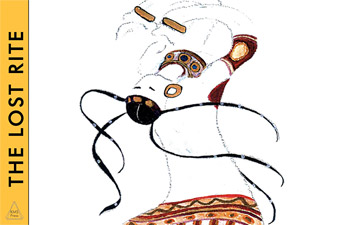
© Camilla Greenwell Photography. (Click image for larger version)
Philharmonia Orchestra & Armitage Gone! Dance
Stravinsky: Rituals – Agon, Rite of Spring, Symphonies of Wind Instruments
★★★✰✰
London, Royal Festival Hall
15 May 2016
www.philharmonia.co.uk
www.armitagegonedance.org
Esa-Pekka Salonen is conducting a Stravinsky festival of five concerts in London between May and September, featuring a number of works probably more familiar to dance-lovers than concert goers. The festival opened on Sunday with a newly choreographed version of Agon, in a programme with the Philharmonia Orchestra playing The Rite of Spring and the less well-known Symphonies of Wind Instruments from 1920.
The concert is being repeated during this summer’s Festival of Aix-en-Provence, which co-funded the participation of Karole Armitage’s company, Armitage Gone! Dance in Agon. Presumably the organisers believe Stravinsky’s ballet score would be easier listening if accompanied by choreography, as it was in the 1957 collaboration between the composer and George Balanchine. The two friends and colleagues created it together, along with 12 New York City Ballet dancers. As Armitage acknowledges in the video introduction to her version, Agon was ‘the single most important generative piece of dance done in the 20th century’, a masterpiece influencing (and intimidating) every ambitious dance-maker ever since.
Most are wise enough to leave the score well alone. Kenneth MacMillan was unfortunate in being encouraged by Ninette de Valois to choreograph Agon for her Covent Garden company only six months after Balanchine’s premiere, which he hadn’t seen. His version was not a success, not least because the Royal Opera House conductor and musicians of the time had no idea how to deal with Stravinsky’s 12-tone music. Clive Barnes commented in a review: ‘Bedevilled by fiendishly bad orchestral playing and never particularly well danced, Agon was a hopeless struggle from the first’.
Armitage has the advantage of an experienced conductor and orchestra, though a considerable drawback in the narrow performance space in the Festival Hall, a platform above the musicians’ heads. She reckoned the setting was so different from the usual ballet stage that the project, ‘a complete folly’ in her own words, was worth undertaking. For her, it was a reversal to her ballet background, a neo-classical aesthetic that she had challenged throughout her 35 years as a radically unconventional choreographer.
In the 2011 Dance Umbrella festival in London, she revived her 1981 Drastic Classicism that first branded her as a punk ballerina. She and her dancers hurled themselves frenziedly around five guitarists playing ear-splitting chords – a clash between technically sophisticated bodies and defiantly strident music that certainly influenced Michael Clark, and probably Wayne McGregor. For much of her long career in Europe and the United States, Armitage used music as a soundscape rather than a primary source of inspiration. Now 62, she has come round to responding to music (including a work to Mozart, Gran Partita, for Rambert in 2007).

© Camilla Greenwell Photography. (Click image for larger version)
For her account of Agon, she has evidently steeped herself in Balanchine’s ballet, which she first danced at the age of 17, with the Grand Théatre de Genève company. She follows his and Stravinsky’s disposition of dancers into trios and duets, including a principal one, although instead of 12 dancers she has just six. She starts and ends in the same way, with two men repeating their moves instead of a male quartet. The Greek meaning of ‘agon’ is a contest or competition, but with Armitage up against Balanchine, it’s more of a travesty.
Balanchine’s choreography both reflects Stravinsky’s 12-tone structure and comments on the composer’s use of baroque dances and instrumentation. The dancers perform as on-stage members of the orchestra; the conductor often takes his cue from their actions on the silent downbeat, the music joining the male dancer in the first trio, for example, as he lands from his opening jump. Not surprisingly, Salonen doesn’t have that intimate a relationship with Armitage’s dancers on their platform above him. They don’t belong in the same performance world.
Armitage doesn’t risk intricate counterpoint or canon in the way Balanchine did. Most of her choreography (unusually for her) is in unison, sometimes with two dancers facing each other in mirror images. The main differences between them is that two women are on pointe, one (Megumi Eda) on three-quarter point; two of the men are slight, while one (William Isaac) is very tall and thickset. Isaac was her principal male dancer from 2003 onwards. Since setting up his own company, Kymera Dance, in 2011, he appears to have put on a lot of weight.
He dances the central pas de deux with Eda in roles originally created on Arthur Mitchell and Diana Adams. Isaac is a muscle man, manipulating the deceptively delicate Eda like a bendy toy. Although he supports her in plunging arabesques and daring lifts, their duet to mysterious, almost sinister strings doesn’t make you hold your breath in the way Balanchine’s astonishing pas de deux does.

© Camilla Greenwell Photography. (Click image for larger version)
The other two women, Izabela Szylinska and Emily Wagner, alternate between insouciance and aggressive athleticism. On pointe, they move almost as boldly as Balanchine dancers, countering their weapon-like legs with ‘baroque’ hand gestures, winsome instead of witty. Two men, Ahmaud Culver and Cristian Laverde Koenig, kickbox and flex their biceps, clenching their hand into fists at the end. Music-lovers in the audience seemed relieved when the dancing was over.
The orchestra was considerably more entertaining to look at (as well as hear). The non-players stayed attentively still at the start of the concert, which opened with a 32 second Fanfare for three trumpets, an early sketch for Agon’s first quartet. Then the wind and brass instruments launched into the dense Symphonies for 12 minutes, seguing directly into Agon. During the interval, the musicians’ seating was rearranged for the forces required for The Rite of Spring, percussion instruments spectacularly arrayed along the rear.
Balanchine was of the opinion that The Rite of Spring needed no choreography. The orchestra is a heaving organism in motion, bows sawing up and down or tapping against strings, heads bobbing, woodwinds erupting, metal gleaming, kettledrums pounding. Climactic sequences look and sound like train crashes, followed by reverberating silence. Salonen conducts with lyrical ports de bras, rising on tiptoe, coat flaring, sweat dripping. He’d be a disaster for dancers, since he speeds up excitedly instead of keeping a steady pulse for a corps de ballet and Chosen One’s dance of death. He brought the audience to our feet in the end, exhilarated with delight at the Rite instead of pity for a sacrificial victim.

















You must be logged in to post a comment.